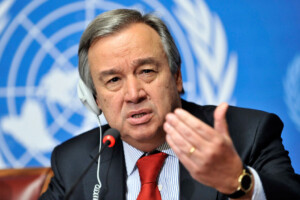WFP: number of food insecure people in Sudan may ‘dramatically increase to unprecedented levels’
The United Nations World Food Programme (WFP) has warned that “a record 15 million people in Sudan – one-third of the population – are currently facing acute food insecurity,” as the WFP’s Comprehensive Food Security and Vulnerability Assessment (CFSVA) shows.
 Muna and her baby Dawat, who receives Plumpy'Sup, nutrition supplements from WFP to treat/prevent Moderate Acute Malnutrition (MAM). They live in Abu Shouk Camp for the Displaced near El Fasher, North Darfur (WFP)
Muna and her baby Dawat, who receives Plumpy'Sup, nutrition supplements from WFP to treat/prevent Moderate Acute Malnutrition (MAM). They live in Abu Shouk Camp for the Displaced near El Fasher, North Darfur (WFP)
The United Nations World Food Programme (WFP) has warned that “a record 15 million people in Sudan – one-third of the population – are currently facing acute food insecurity,” as the WFP’s Comprehensive Food Security and Vulnerability Assessment (CFSVA) shows.
In a new report, released yesterday, the WFP explained that the “already alarming food security situation is likely to worsen throughout the lean season in Sudan, which started this month and will last through September”. By that month, up to 40 per cent of Sudanese may slip into food insecurity, WFP and the Food and Agricultural Organisation of the United Nations (FAO) warned.
“The combined effects of conflict, climate shocks, economic and political crises, rising costs, and poor harvests are pushing millions of people deeper into hunger and poverty”, said the WFP’s Representative and Country Director in Sudan, Eddie Rowe.
‘The combined effects of conflict, climate shocks, economic and political crises, rising costs, and poor harvests are pushing millions of people deeper into hunger and poverty’ – Eddie Rowe
The FAO Representative in Sudan, Babagana Ahmadu, explained that “in the 2021/2022 harvest year, Sudan was able to produce 5.1 million tons of cereal, enough to cover the needs of less than two thirds of the population”. “If the ongoing agriculture season doesn’t receive robust support with agricultural inputs and livestock services, the number of food insecure people may dramatically increase to unprecedented levels and ultimately lead to more conflict and displacement”, he said.
The WFP statement further explained that a combination of the economic and political crisis, conflict and displacement, climate shocks, including droughts and floods, and a poor harvest in the past agricultural season are key drivers of the current levels of food insecurity in Sudan.
“To compound the situation, the conflict in Ukraine is further driving up food and fuel prices in Sudan, which is dependent on food imports with more than half of the country’s wheat imports stemming from the Black Sea region”, the WFP explained.
Darfur
The CFSVA assessment shows that food insecurity exists in all 18 states of Sudan and has worsened in 16 of those states. The ten most affected localities are in the Darfur region, “which have been ravaged by nearly two decades of protracted conflict and displacement”.
The most affected locality is in Kereinik, West Darfur, where renewed clashes at the end of April claimed the lives of at least 179 people and displaced around 125,000. The CFSVA analysis shows that up to 90 percent of the population in Kereneik is food insecure.
Read the full report here.











 and then
and then